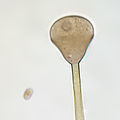Armenian cuisine: Difference between revisions
CSV import |
CSV import |
||
| Line 1: | Line 1: | ||
== Apophysomyces variabilis == | |||
'''''Apophysomyces variabilis''''' is a species of fungus in the order [[Mucorales]], which is known to cause infections in humans, particularly in tropical and subtropical regions. This organism is part of the [[Apophysomyces]] genus, which includes several other species that are also pathogenic to humans. | |||
== | === Morphology === | ||
''Apophysomyces variabilis'' is characterized by its filamentous structure, typical of fungi in the Mucorales order. The hyphae are broad and non-septate, which means they do not have cross-walls. The sporangia, which are the spore-producing structures, are spherical and borne on long sporangiophores. The apophysis, a swelling at the base of the sporangium, is a distinctive feature of this genus. | |||
=== Pathogenicity === | |||
''Apophysomyces variabilis'' is an opportunistic pathogen, meaning it primarily causes disease in individuals with weakened immune systems or those who have suffered trauma. Infections can occur following the inhalation of spores or through traumatic implantation of the fungus into the skin. The resulting condition is known as [[mucormycosis]], which can manifest in various forms, including cutaneous, rhinocerebral, and disseminated infections. | |||
=== Clinical Manifestations === | |||
The clinical presentation of infections caused by ''Apophysomyces variabilis'' can vary depending on the site of infection. Cutaneous infections often occur following trauma and can lead to necrotizing fasciitis, a severe soft tissue infection. Rhinocerebral mucormycosis involves the sinuses and can extend to the brain, while disseminated infections can affect multiple organ systems. | |||
=== Diagnosis === | |||
Diagnosis of ''Apophysomyces variabilis'' infections typically involves a combination of clinical evaluation, imaging studies, and laboratory tests. Microscopic examination of tissue samples can reveal the characteristic broad, non-septate hyphae. Culture of the organism can confirm the diagnosis, although it may be challenging due to the fastidious nature of the fungus. | |||
== | === Treatment === | ||
Treatment of infections caused by ''Apophysomyces variabilis'' often requires a combination of surgical intervention and antifungal therapy. Surgical debridement of infected tissue is crucial to remove necrotic material and reduce fungal load. Antifungal medications such as [[amphotericin B]] are commonly used, although the choice of drug may vary based on the specific clinical scenario and patient factors. | |||
* | == Related pages == | ||
* [[Mucormycosis]] | |||
* [[Fungal infection]] | |||
* [[Opportunistic infection]] | |||
== Gallery == | |||
<gallery> | |||
File:Apophysomyces_variabilis.jpg|''Apophysomyces variabilis'' | |||
</gallery> | |||
[[Category:Fungi]] | |||
[[Category:Pathogenic fungi]] | |||
[[Category:Mucorales]] | |||
[[Category: | |||
[[Category: | |||
[[Category: | |||
Latest revision as of 18:47, 11 February 2025
Apophysomyces variabilis[edit]
Apophysomyces variabilis is a species of fungus in the order Mucorales, which is known to cause infections in humans, particularly in tropical and subtropical regions. This organism is part of the Apophysomyces genus, which includes several other species that are also pathogenic to humans.
Morphology[edit]
Apophysomyces variabilis is characterized by its filamentous structure, typical of fungi in the Mucorales order. The hyphae are broad and non-septate, which means they do not have cross-walls. The sporangia, which are the spore-producing structures, are spherical and borne on long sporangiophores. The apophysis, a swelling at the base of the sporangium, is a distinctive feature of this genus.
Pathogenicity[edit]
Apophysomyces variabilis is an opportunistic pathogen, meaning it primarily causes disease in individuals with weakened immune systems or those who have suffered trauma. Infections can occur following the inhalation of spores or through traumatic implantation of the fungus into the skin. The resulting condition is known as mucormycosis, which can manifest in various forms, including cutaneous, rhinocerebral, and disseminated infections.
Clinical Manifestations[edit]
The clinical presentation of infections caused by Apophysomyces variabilis can vary depending on the site of infection. Cutaneous infections often occur following trauma and can lead to necrotizing fasciitis, a severe soft tissue infection. Rhinocerebral mucormycosis involves the sinuses and can extend to the brain, while disseminated infections can affect multiple organ systems.
Diagnosis[edit]
Diagnosis of Apophysomyces variabilis infections typically involves a combination of clinical evaluation, imaging studies, and laboratory tests. Microscopic examination of tissue samples can reveal the characteristic broad, non-septate hyphae. Culture of the organism can confirm the diagnosis, although it may be challenging due to the fastidious nature of the fungus.
Treatment[edit]
Treatment of infections caused by Apophysomyces variabilis often requires a combination of surgical intervention and antifungal therapy. Surgical debridement of infected tissue is crucial to remove necrotic material and reduce fungal load. Antifungal medications such as amphotericin B are commonly used, although the choice of drug may vary based on the specific clinical scenario and patient factors.
Related pages[edit]
Gallery[edit]
-
Apophysomyces variabilis
